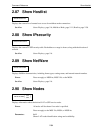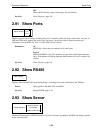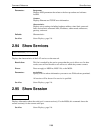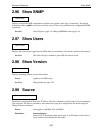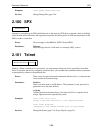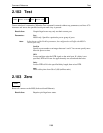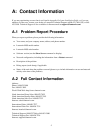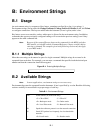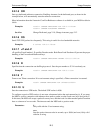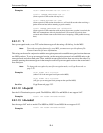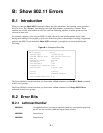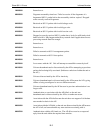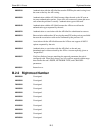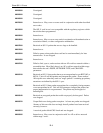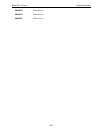
Environment Strings Usage Examples
B-2
B.2.1 Usage Examples
These examples should illustrate the proper usage of the above environment strings.
2.2.1.1 nnnn
Sets a socket number. For TCP and UDP connections only. The most common socket numbers are 7000
(the MSS remote console port), 200x (for Telnet IAC interpretation), and 300x (for raw TCP/IP), where x
is the number of the desired serial port.
Examples
% telnet 192.0.1.88:7000
(connects to the remote console port of the specified host)
% telnet 192.0.1.66:3001
(forms a raw TCP/IP connection to the MSS serial console port)
Local> TELNET 192.0.1.45:2003
(forms a connection with Telnet IAC interpretation to the third serial port of an MSS4)
See Also Your MSS Installation Guide for more information on socket connections
2.2.1.2 +C and -C
+C specifies CR to CRLF. -C specifies CR to LF.
Examples
Local>> CHANGE PREFERRED TELNET 192.0.1.3:+C
2.2.1.3 +D and -D
+D sets Backspace mode. -D sets Delete mode.
Examples
% telnet 192.0.1.5:-D
2.2.1.4 +E and -E
+E sets Local Echo mode. -E sets Remote Echo mode.
Examples
% telnet 192.0.1.48:+E
R Rlogin protocol (sets port number to 513 if not already set)
T TCP mode (raw uninterpreted data stream)
U
S
xxxx
UDP mode (the default UDP socket is 4096)
Specifies session mode. Only valid with U.
Timeout value in seconds, up to 3600 (1 hour). Only valid
with :S
Y Encrypted mode (raw TCP socket that encrypts all data
using a 56-bit key)
LD=port# Sets the LAT destination port to port#
LN=node# Sets the target LAT node to node#
Table B-1: Environment Strings



